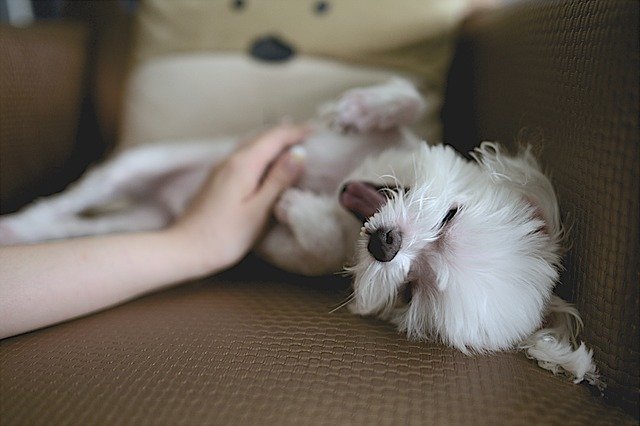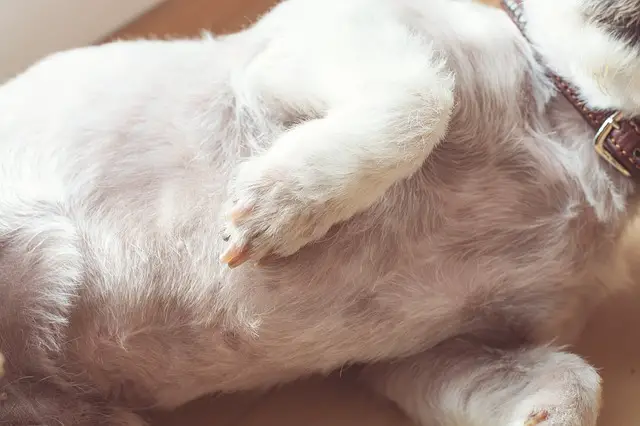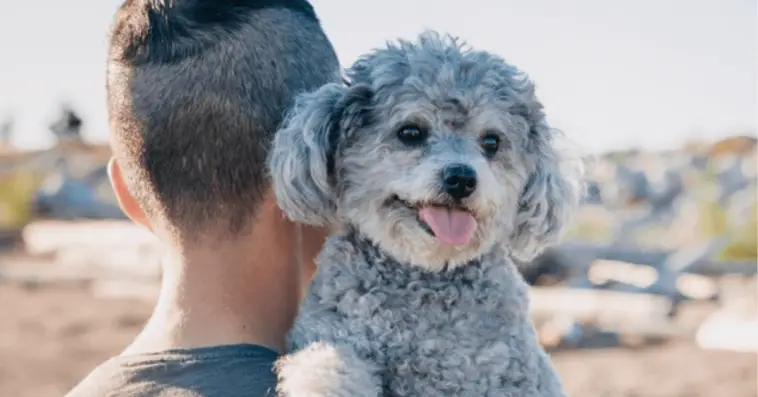It can be surprising and worrisome to see a male dog having swollen nipples. You might wonder ‘What does it mean when a male dog’s nipples are swollen?’
And that is exactly the topic of this article.
Here we will discuss:
- 4 Tips to Help a Male Dog That Has Swollen Nipples
- 10 Reasons What it Means When a Male Dog’s Nipples are Swollen
- And more…
What Does it Mean When a Male Dog’s Nipples are Swollen?
When a male dog’s nipples are swollen, it could be due to hyperestrogenism, mastitis, or an irritation caused by the environment, pests, or parasites. Swollen nipples can also be a result of poor diet, an underlying infection or tumor. Anemia and certain drugs can also be the culprits behind swollen nipples in dogs.
10 Reasons Behind What Does it Mean When a Male Dog’s Nipples are Swollen?

Typically, female dog’s nipples tend to get swollen due to pseudo-pregnancy, mammary gland tumors, or mastitis. But even some male dog owners might notice swollen nipples on the pet due to one of the following causes:
1. Mastitis
According to Dr. Catherine Barnette, DVM, mastitis is an inflammation or infection of the mammary glands. It is also one of the most common reasons behind swollen teats in all mammals including dogs.
In female dogs, mastitis occurs when e.coli bacteria enter in the mammary glands causing a swelling in the teats. This is typically seen in pregnant and nursing bitches.
But in male dogs, mastitis can be attributed to trauma or injury.Your pet might have hurt itself while playing and the injury could result in e.coli bacteria entering in its mammary glands. Another animal or dog could have scratched or bitten its nipple resulting in mastitis.
Insect bites, cuts from grooming brushes, a foreign object getting lodged into the skin can also result in swollen nipples or mastitis in male dogs.
Another common cause behind mastitis in dogs is bacteria caused by a dirty environment. If your dog has a habit of lounging on dirty floors or out in the yard, then that could also result in mastitis. This is typically more common in old, sick, and immune-compromised dogs
It is best to have your vet diagnose this condition because further testing is very important to rule out tumors of the mammary gland.
In extreme cases, the mammary glands could be severely infected and couldeven result in sepsis or blood infection. This may prompt surgical removal of the glands. That is why it is best to have your veterinarian examine your pet right away.
2. Hyperestrogenism
According to PetMD, hyperestrogenism in dogs can cause swollen teats in male dogs. It occurs due to an over-production of estrogen. Estrogen is produced in the ovaries (in female dogs) and in the testicles (in male dogs).Estrogen hormone is also found in some foods like soy.
In male dogs, hyperestrogenism may be seen in the following cases:
- Toy breeds that get exposed to estrogen due to the transdermal (skin patches) used by their human owners for hormone replacement therapy.
- In older male dogs with testicular cancer, hyperestrogenismmay be a symptom of the cancer that couldresult in swollen nipples.
- Certain medicines like diethylstilbestrol (used for treating enlarged prostate in male dogs) can also cause an over-secretion of estrogen.
Other symptoms of excess estrogen in male dogs include:
- Weakness
- Lethargy
- Thinning of hair and fur loss
- Female characteristics
- Pale gums
- Blood in stool, urine, and vomit.
- Tumor on the tail
- Testicular atrophy
Your vet can diagnose hyperestrogenism through blood tests, ultrasound of the abdomen, and even X-rays or biopsy.
Treatment generally includes medication, neutering surgery, stopping estrogen-based drugs/supplements, and antibiotics to treat secondary infections.
Also Read: Best Age to Spay A Chihuahua
3. Abscess caused by pests/parasites
According to journalist Matthew Nesbitt who is specializes in animal research, the answer to the question: what does it mean when a male dog’s nipples are swollen is- an infection caused by pests or parasites.
If a dog is in a dirty environment, a parasite could easily bite and burrow into its nipple and infect the underlying mammary gland. The mammary gland tissue is very sensitive and even male dogs can experience swelling and infection from such causes.
Sometimes, this can even result in an abscess. An abscess is a pus-filled swelling in the skin underneath the mammary gland. It is very painful and might even need surgical draining of the pus under local anesthesia.Your dog will also need a course of antibiotics to treat the abscess.
Also Read: 6 Super Easy Ways to Get Rid of Fleas on Dogs
4. Mammary gland tumors
Mammary gland tumors are rare but not unheard of in male dogs. They are common in breeds like German shepherd and toy and miniature poodles.
Mammary gland tumors could be cancerous or non-cancerous. Some dogs can have both at the same time. The clinical signs of mammary gland tumors, in addition to swollen or enlarged nipples are:
- A lump or mass under the nipple – you or your dog groomer might notice it.
- In advanced cases, the tumor can get ulcerated and bleed.
- Your dog might lick the swollen teat repeatedly.
- As the tumor grows, your dog might show reduced appetite, weight loss, and vomiting/diarrhea, and breathing difficulty.
Your vet willorder X-rays, scans, and biopsy of the lump to diagnose the condition. Treatment generally includes surgical removal of the gland, radiation therapy, and anti-inflammatory medicines.
5. Other cancers
In male dogs, swollen nipples can also result from medications administered to treat testicular cancer or as a result of the cancer itself.
Clinical signs of testicular cancer are:
- Soft swelling in one or both testicles
- Nipple elongation
- Scrotal enlargement
- Hair changes
- Mammary enlargement due to increased estrogen production/hyperestrogenism
- Squatting to urinate and other behavioral changes
- Reduced sex drive.
Your vet can diagnose the condition through blood tests, X-rays, ultrasound, and biopsy. Treatment normally includes surgical castration, radiotherapy, and chemotherapy.
6. Anemia
According to AKC, anemia can also caused enlarged or swollen nipples in male and female dogs. It is the condition where the dog’s blood has reduced production of red blood cells circulating and that can interfere with the oxygen intake and CO2 removal.
Remember: anemia is not a disease; rather it is a symptom of a disease. Numerous factors can cause anemia in dogs – typically poor nutrition or low-quality food, certain underlying health conditions including cancer, tick bites, toxins, kidney disease, hypothyroidism, etc.
Clinical signs of anemia in dogs are:
- Pale gums
- Weakness and fatigue
- Bruises easily
- Dark tarry stools and bloody vomit
In dogs, a blood test called the PCV or Packed Cell Volume can show if your dog is anemic. If the test result is less than 35%, your dog is considered as anemic. Treatment includes medicines to increase iron and hemoglobin. In extreme cases, your pet might need blood transfusion.
7. Abdominal pain/bloat
The male dog’s nipples are situated all over the underside of the dog on its belly and extending between its chest and the groin. Any abdominal swelling or bloat can result in a swelling in the nipple area. Abdominal swelling can result from one of the following conditions:
- Bloat or gastric dilation volvulus – this condition is common in dogs with deep chests like Cane Corsos, Great Danes etc. It can also occur in dogs that eat too fast.
- Cushing’s syndrome – This is another possible answer to what does it mean when a male dog’s nipples are swollen. The syndrome results in an overproduction of cortisol hormone and could result in a pot-bellied appearance. A tumor on the adrenal gland can also cause Cushing’s.
- Ascites – Asictes results in accumulation of fluid in the abdomen. It could also be a result of heart disease, liver disease, kidney failure, or severe intestinal disease.
Your vet will diagnose the exact cause of abdominal pain through a series of tests, scans, and blood work. Once treatment begins – usually medicine or surgery to remove tumor etc., your dog’s nipple swelling should also go down.
Also Read: 10 Amazing Benefits of Elevated Food Bowls for Dogs
8. Infection/Peritonitis
According to Dr. Prof Thomas Wittek, peritonitis or septic peritonitis is a result of an infection of the kidneys, liver disease, accumulation of fluid in belly, disruption in the gastrointestinal tract, kidneys, or pelvic inflammation. This infection can result in swollen nipples or swollen abdominal area in male and female dogs.
Other clinical signs of peritonitis are:
- Fever
- Vomiting
- Reduced blood pressure
- Fluid accumulation
- Rupture of intestinal tract
- Shock.
Treatment first includes treating the dog for shock and preventing dehydration from fluid loss. Your vet might even add some drains to remove accumulated fluid. The affected dogs often need intravenous feeds.
9. Symmetric hair loss/Symmetric flank alopecia
If your dog has puffy nipples, it may be due to symmetric hair loss or symmetric flank alopecia.
The nipples puff or swell up since they get exposed to environment due to the extreme hair loss.
According to Dr. Catherine Barnette, symmetric flank alopecia can occur due to hormonal imbalances, fungal skin infections, or even genetic reasons. It is a common condition in the Boxer dog breed.
Your vet might order some blood tests to note your dog’s thyroid levels. S/he might also take some skin scrapes to eliminate skin issues or fungal infections. In severe cases, a skin biopsy may be needed to diagnose symmetric flank alopecia.
Treatment includes treating the underlying health issue. Melatonin supplements can help in hair regrowth.
10. Poor quality dog food
Inadequate nutrition can compromise your dog’s immune system. This can lead to many health problems like anemia and other infections.
A dirty environment can add to your dog’s woes – slightest of parasitic attacks, germs, and cuts caused by brushes or another dog’s bites can result in mastitis or abscessed mammary glands.
A low-quality diet with fillers like soy can also cause hormonal imbalance in male and female dogs. Research shows that certain pet foods also contain thyroid hormones which too can result in recurring swollen nipples .Switching to high-quality dog food can be the best way of preventing this.
4 Tips to Help a Male Dog With Swollen Nipples

Here are some ways to deal with a male dog having swollen nipples:
1. Stay calm and observe for a few days
Dogs generally self regulate – especially if your dog is healthy, eating well, and behaving normally, it might not be a cause for concern.
Often, a small injury or scratch might have caused the swelling. It should resolve on its own in a couple of days.
2. Watch out for other clinical signs like discharge or redness
You can gently press on the swelling and observe your dog’s reaction. If your dog whines or yelps there could be an abscess or a tumor in the mammary gland. See your vet right away. Antibiotics can treat mild abscesses easily.
If there are any other signs like a lump that changes size or shape, skin discoloration, oozing nipples, redness, excessive hair loss, licking or biting of nipples, whimpering, weight loss, lethargy, vomiting, etc. then too you must see your vet right away.
3. Use warm compresses
Apply a warm compress to your dog’s nipples in the following manner:
- Warm up a cloth on a hot griddle or in the microwave oven(you could also use a heated rice-filled sock with its open end tied off) to make the compress.
- Test the compress’s temperature on your inner arm. It should feel comfortable on your skin. If it is too hot for you, it could be too hot for your dog.
- Gently apply the compress on your pet’s swollen nipples.
- Observe your dog. If it shows signs of distress, stop and seek your vet’s opinion.
4. Make dietary changes
Consult your vet and make some dietary changes for your dog. You may want to switch to a high-quality dog food to reduce hormonal imbalances and also strengthen your dog’s immune system. Any dietary change will take some time to show results, so be patient.


